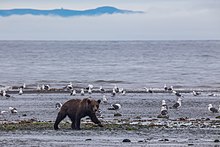You can help expand this article with text translated from
the corresponding article in Russian. (July 2023) Click [show] for important translation instructions.
|
| East Siberian brown bear Russian: Восто́чно-Сиби́рский бурый медведь | |
|---|---|
|
Scientific classification
| |
| Domain: | Eukaryota |
| Kingdom: | Animalia |
| Phylum: | Chordata |
| Class: | Mammalia |
| Order: | Carnivora |
| Family: | Ursidae |
| Genus: | Ursus |
| Species: | |
| Subspecies: | U. a. collaris
|
| Trinomial name | |
| Ursus arctos collaris F. G. Cuvier, 1824
| |
| Synonyms | |
|
jeniseensis Ognev, 1924 | |
The East Siberian brown bear (Ursus arctos collaris) is a population or subspecies of brown bear which ranges from eastern Siberia, beginning at the Yenisei river, north to the Arctic Circle, as far as Trans-Baikaliya, the Stanovoy Range, the Lena River, Kolyma and generally throughout Yakutia and the Altai Mountains. The subspecies is also present in northern Mongolia, northern Xinjiang, and eastern Kazakhstan. [2]
Size

East Siberian bears are intermediate in size to Eurasian brown bears and Kamchatka brown bears, though large individuals can attain the size of the latter. Their skulls are invariably larger than those of Eurasian brown bears and are apparently larger than those of Kamchatka brown bears. [3]
Adult males have skulls measuring 32.6–43.1 cm (12.8–17.0 in) in length, and 31.2–38.5 cm (12.3–15.2 in) wide at the zygomatic arches. They have long, dense and soft fur which is similar in colour to that of Eurasian brown bears, though darker coloured individuals predominate.

Taxonomic history
Originally, Cuvier's trinomial definition for this subspecies was limited to brown bear populations in the upper Yenisei river, in response to bears there sporting well-developed white collars. The subspecies has since been reclassified as encompassing populations formerly classed as jeniseensis and sibiricus, though the latter two lack the collar. [3]
Behaviour and ecology

Siberian bears tend to be much bolder toward humans than their shyer, more persecuted European counterparts. They regularly destroy hunters' storages and huts where there is food. [4] They are also more carnivorous than their European counterparts [4] and do not seem to like honey.[ citation needed] Like other brown bears, their diet includes fish, berries, roots and tubers, small mammals such as hares, and larger mammals such as caribou and elk. [2]
References
- ^ "IUCN Brown Bear subspecies status". Retrieved August 29, 2022.
- ^ a b "East Siberian brown bear". Bear Conservation. 2023-07-15. Archived from the original on 2023-07-15. Retrieved 2023-07-17.
- ^ a b V. G. Heptner; N. P. Naumov, eds. (1998). Mlekopitajuščie Sovetskogo Soiuza. Moskva: Vysšaia Škola [Mammals of the Soviet Union, Volume II, Part 1a, Sirenia and Carnivora (Sea cows; Wolves and Bears)]. Vol. II, Part 1a. Washington, D.C., USA: Science Publishers, Inc. ISBN 1-886106-81-9.
- ^ a b Baskin, Leonid (2023-07-17). "WOLVES, BEARS AND HUMAN ANTI-PREDATOR ADAPTATIONS". ResearchGate. Retrieved 2023-07-17.
